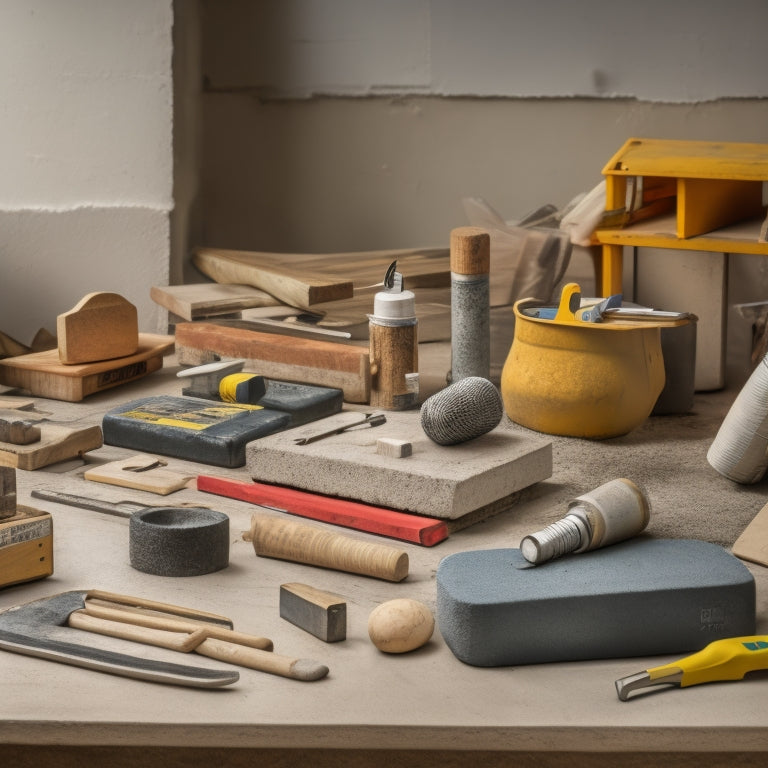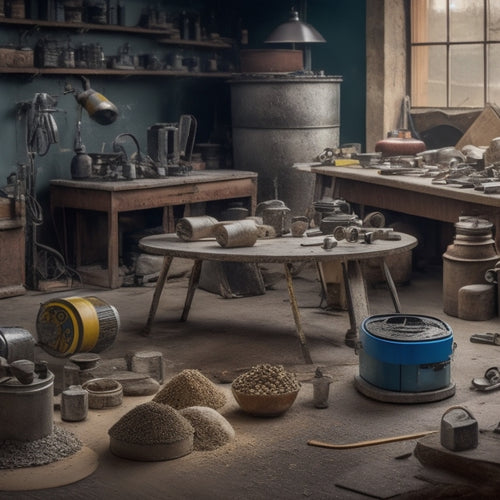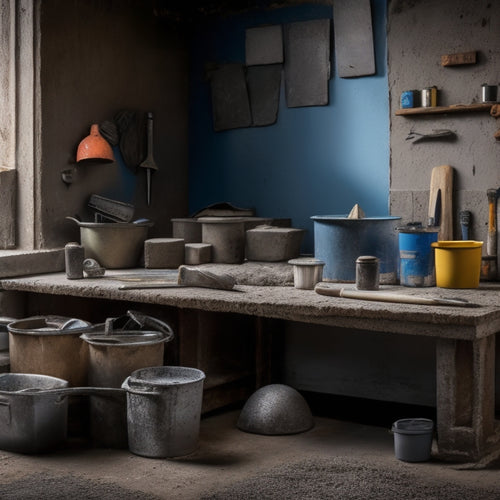
Why You Need These Concrete Block Laying Tools
Share
You can't afford to skip using essential concrete block laying tools on your construction project, as they directly impact the structural integrity, aesthetic appeal, and overall quality of your finished product. From tamping tools that guarantee a solid foundation to leveling instruments and spirit levels that assure accurate alignment, each tool plays a critical role in achieving a professional finish. Block cutting saws, rubber mallets, and joint spacers also help maintain precision and consistency throughout the project. By investing in these tools, you'll not only prevent costly mistakes but also elevate the quality of your work - and now, it's time to explore how to make the most of these essential tools.
Key Takeaways
• Achieving a solid foundation requires essential tools like tamping tools, leveling instruments, and line and pin for accurate block alignment and prevention of structural issues.
• Proper tools ensure accuracy, precision, and efficiency, resulting in a superior finished product, client satisfaction, and a strong professional reputation.
• Quality tools like block cutting saws, rubber mallets, and joint spacers prevent damage, waste, and errors, saving time and resources on the job site.
• Essential safety equipment like safety gloves protect hands from abrasions, cuts, and chemicals, ensuring a safe working environment and reducing the risk of accidents.
• Investing in the right tools and equipment prevents costly mistakes, ensures compliance with building codes, and guarantees a long-lasting, high-quality concrete block structure.
Tamping Tool for Solid Foundation
You'll need a reliable tamping tool to assure a solid foundation by compressing the soil and removing air pockets. Think of it as the unsung hero of concrete block laying. Without proper tamping, your foundation can turn into a wobbly mess, and we all know how that ends – in a pile of rubble and regret.
Mastering tamping techniques is essential for foundation stability. You want to make certain the soil is compacted evenly, eliminating any weak spots that could compromise the structure's integrity. A good tamping tool will help you achieve just that. It's not just about whacking the soil with a stick; it's about applying the right amount of pressure, in the right spots, to get the job done.
When choosing a tamping tool, look for one that's sturdy, durable, and easy to handle. You'll be using it extensively, so make sure it's comfortable to hold and maneuver.
With the right tool and a bit of practice, you'll be a tamping pro in no time, laying the groundwork for a solid, long-lasting structure that'll make you proud.
Leveling Instruments for Accuracy
When you're laying concrete blocks, you need to make certain the surface is perfectly level and plumb.
You'll use leveling instruments to check the grade level and assure it's even, which is critical for a solid structure.
Check the Grade Level
Before laying the first block, verify the grade level is accurate by using leveling instruments to confirm the surface elevation and plane. You don't want your beautiful blocks to end up wonky, do you? This vital step guarantees your structure will be stable and even. It's all about grade evaluation, baby!
Here's what you need to do:
-
Check the soil assessment to identify any potential settlement issues. You don't want your blocks sinking into the ground like a failed soufflé.
-
Use a level to confirm the surface is even and plumb. No wonky walls allowed!
-
Verify the elevation is correct to avoid any drainage issues. You don't want water pooling around your structure, do you?
- Double-check your calculations to guarantee the grade level matches the design specs. Math is hard, but someone's gotta do it!
Ensure Perfect Plumbness
What leveling instruments do you need to guarantee perfect plumbness and accuracy in your concrete block laying project? Well, let's get straight to it!
You'll need a reliable spirit level, a laser level, and a trusty plumb bob. Yes, that old-school plumb bob is still a lifesaver when it comes to assuring your walls are perfectly vertical.
Mastering plumb bob techniques will become your superpower in achieving wall alignment tips that'll make your structure stand tall and proud. For instance, use your plumb bob to create a reference line, and then use your spirit level to check for any deviations. Don't forget to double-check your work – you don't want any wonky walls ruining your masterpiece!
When it comes to large-scale projects, a laser level is a game-changer. It projects a level line or dot, allowing you to assure your blocks are perfectly aligned.
With these leveling instruments in your toolkit, you'll be well on your way to building a structurally sound and visually stunning concrete block structure. So, don't skimp on these essentials – your project's accuracy depends on it!
Block Cutting Saw for Precision
When you're working with concrete blocks, you need a block cutting saw that delivers clean cuts every time.
With precise angle adjustments, you'll be able to make exact cuts that fit together seamlessly.
Clean Cuts Every Time
You achieve clean cuts every time with a block cutting saw, a precision tool designed to slice through concrete blocks with accuracy and control. This baby's got skills, and it's about to become your new BFF on the construction site.
With a block cutting saw, you'll master various cutting techniques, ensuring clean edges and reducing waste. No more rough, crumbling cuts that'll make you wanna cry (been there, done that, right?).
Here's what you can expect from this bad boy:
-
Accurate cuts: Slice through blocks like a hot knife through butter, without compromising on precision.
-
Reduced waste: Clean cuts mean less waste, saving you time, money, and Mother Earth's resources.
-
Increased productivity: With a block cutting saw, you'll work faster and more efficiently, getting the job done in no time.
- Professional results: Your clients will be impressed with the quality of your work, and you'll be the hero of the construction site.
Precise Angle Adjustments
With the block cutting saw's precision angle adjustment feature, it's possible to make precise cuts at any angle, ensuring a perfect fit for even the most complex masonry projects. You'll no longer struggle with wonky cuts that throw off your entire layout.
This feature is especially vital when working with curved walls or intricate designs, where accuracy is paramount.
Thanks to the saw's adjustable cutting tools, you can fine-tune your angle measurement techniques to get it just right. Say goodbye to tedious trial-and-error methods and hello to precision cuts that'll make your clients (or your contractor's hat) spin with excitement.
The block cutting saw's precision angle adjustment feature allows you to make precise adjustments in mere seconds, saving you time and effort on the job site. With this level of control, you can tackle even the most demanding projects with confidence.
Spirit Level for Straight Lines
A spirit level guarantees accurate plumb and level lines, allowing you to establish a precise reference point for laying concrete blocks. This tool is essential for ensuring your blocks are aligned correctly, which is critical for the structural integrity of your project.
Without a spirit level, you're relying on guesswork, and let's be honest, who wants to risk a wobbly wall or a wonky foundation?
When choosing a spirit level, consider the following benefits:
-
Accurate readings: A good spirit level provides reliable and precise measurements, taking the guesswork out of your work.
-
Durability: Look for a level that can withstand the rough conditions of a construction site.
-
Ease of use: A user-friendly spirit level saves you time and frustration, allowing you to focus on the task at hand.
- Versatility: Choose a level that can be used for a variety of tasks, from checking plumbing to ensuring level surfaces.
Rubber Mallet for Gentle Taps
To guarantee precise block alignment, you'll need a tool that provides a gentle yet firm tap, and that's where a rubber mallet comes in. This trusty tool is designed to deliver a controlled amount of force, allowing you to nudge those blocks into place without applying too much pressure.
The rubber mallet benefits are clear: it prevents damage to the blocks, reduces the risk of chipping or cracking, and assures a snug fit.
When it comes to rubber mallet usage, it's all about finesse. You'll use it to tap blocks into place, making adjustments as needed to achieve perfect alignment.
The rubber head absorbs shock, reducing the impact on the blocks and surrounding surface. This means you can work with confidence, knowing that your blocks will stay put without compromising the structural integrity of your project.
Line and Pin for Alignment
You'll stretch a string line between pins to establish a precise reference point, ensuring your blocks align perfectly along the course. This alignment technique is essential for a professional-looking finish. With the line and pin, you'll avoid wonky walls and uneven surfaces, saving you time and frustration in the long run.
Here are some benefits of using a line and pin for alignment:
-
Improved accuracy: The string line serves as a visual guide, helping you place blocks with precision and accuracy.
-
Efficient workflow: With a clear reference point, you can work faster and smarter, rather than constantly checking and re-checking your work.
-
Reduced errors: The line and pin system minimizes the risk of human error, ensuring your blocks are aligned correctly from the start.
- Enhanced quality: By using alignment tools like the line and pin, you can achieve a higher level of craftsmanship, resulting in a better-looking finished product.
Joint Spacers for Even Gaps
Precision joint spacers guarantee consistent gap widths between blocks, allowing for even mortar distribution and a superior finish. You'll be amazed at how these little tools can make a big difference in your concrete block laying game.
With joint spacers, you can achieve uniform gaps, which is essential for structural integrity and aesthetics. There are various joint spacer types to choose from, including plastic, metal, and foam, each with its own advantages and disadvantages.
When selecting a joint spacer, consider the gap measurement you need. Do you need a standard 3/8 inch gap or something more specific? Make sure to choose a spacer that can accommodate your requirements.
By using joint spacers, you'll avoid the hassle of manually measuring and adjusting gaps, saving you time and effort. Plus, you'll reduce the risk of errors and inconsistencies, ensuring a professional-looking finish.
Mixing Bucket for Consistency
With uniform gaps between blocks guaranteed by joint spacers, you can focus on consistently mixing mortar to the right consistency, and that's where a mixing bucket comes in. This essential tool guarantees you're mixing your mortar to the perfect ratio, every time. A good mixing bucket is more than just a container – it's a key to achieving consistent results.
Here are a few things to reflect on when choosing the right mixing bucket for the job:
-
Material matters: Look for buckets made from heavy-duty, rust-resistant materials like steel or polyethylene. They can withstand the rigors of mixing and cleaning.
-
Size it up: Choose a bucket that's large enough to hold the right amount of mortar for your project, but not so large that it becomes unwieldy.
-
Mixing techniques matter: A bucket with a non-slip handle and a rounded bottom makes it easier to scrape out every last bit of mortar, reducing waste and improving mixing techniques.
- Easy cleaning is a must: A bucket with a smooth, non-porous surface makes cleaning up a breeze, saving you time and effort.
Safety Gloves for Protection
When handling concrete blocks and mixing mortar, your hands are constantly exposed to abrasion, cuts, and harsh chemicals, making safety gloves an essential component of your protective gear. You don't want to risk losing a finger or getting a nasty infection from a cut, do you? That's why you need gloves that can withstand the rough stuff.
Look for gloves made from durable materials like heavy-duty nylon, synthetic rubber, or even Kevlar. These materials provide excellent protection against abrasion and cuts. Some gloves also feature reinforced palms and fingers for added protection. For hand safety, choose gloves with a grip pattern on the palm to prevent slipping and dropping those heavy blocks.
Don't settle for cheap, flimsy gloves that won't last a day on the job site. Invest in high-quality gloves that will keep your hands safe and protected. Remember, your hands are your most valuable tools, so treat them right! With the right safety gloves, you can focus on getting the job done without worrying about your hand safety.
Frequently Asked Questions
Can I Use a Regular Hammer Instead of a Rubber Mallet?
You can use a regular hammer, but don't expect it to be your best friend on the job site.
When it comes to hammer comparison, a rubber mallet wins hands down for concrete block laying.
It's all about tool efficiency - a mallet absorbs shock, reducing the risk of block damage and fatigue. Trust us, your back (and the blocks) will thank you.
How Do I Clean and Maintain My Concrete Block Laying Tools?
You're the conductor of a well-oiled machine, and your concrete block laying tools are the instruments.
To keep the symphony going, you need to clean and maintain them regularly.
Store your tools in a dry, organized space to prevent rust and damage.
For tough grime, use a gentle cleaning solution and a soft-bristled brush to avoid scratching.
Regular tune-ups will keep your tools in top shape, ensuring your next project is a masterpiece.
Are Joint Spacers Necessary for Small Concrete Block Projects?
So, you're wondering if joint spacers are necessary for small concrete block projects? Well, let's get down to business!
Joint spacers bring several benefits to the table, even for small projects. They guarantee consistent joint widths, reduce mortar mess, and save you time in the long run.
Think of them as tiny, efficient superheroes. By using joint spacers, you'll boost your small project efficiency and achieve professional-looking results.
Trust us, it's worth the extra effort!
Can I Use a Spirit Level for Ensuring Plumb Lines as Well?
You're channeling your inner Bob the Builder, verifying those concrete blocks are stacked like a pro!
Now, about that spirit level: yes, you can use it to verify plumb lines, but don't rely solely on its accuracy.
Combine it with other plumb line techniques, like checking for straight lines and using a string line, to guarantee precision.
Trust us, your structure (and your reputation) will thank you!
Are Mixing Buckets Suitable for Mixing Other Types of Materials?
You're wondering if your trusty mixing buckets can handle more than just concrete. Well, it depends on the mixing techniques and material compatibility.
While buckets are versatile, they're not a one-size-fits-all solution. For instance, mixing epoxy or paint requires a clean, residue-free environment, which your concrete-stained bucket mightn't provide.
Be cautious when mixing other materials, and consider dedicating a bucket to each specific task to avoid contamination and guarantee the best results.
Conclusion
You've got the right tools, now it's time to get to work!
Remember, 'measure twice, cut once' to guarantee a solid foundation for your concrete block project.
With these essential tools, you'll be well on your way to a professional-looking result.
Don't skimp on quality or accuracy - the extra effort will pay off in the long run.
Stay focused, stay safe, and you'll be enjoying your new structure in no time!
Related Posts
-

Top DIY Concrete Grinding and Polishing Tools
When selecting DIY concrete grinding and polishing tools, you'll want to take into account a range of factors to guar...
-

7 Must-Have Tools for Concrete Repair Organization
To effectively organize your concrete repair projects, you'll need a thorough toolkit that includes a well-planned st...
-

Top Tools for Beginners in Concrete Masonry Coating
You're about to begin a concrete masonry coating project, and having the right tools is essential. Start with essenti...


